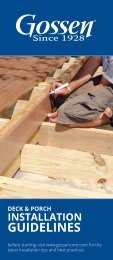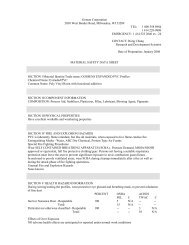Installation Guide - Gossen
Installation Guide - Gossen
Installation Guide - Gossen
Create successful ePaper yourself
Turn your PDF publications into a flip-book with our unique Google optimized e-Paper software.
T&G Porch Floor <strong>Installation</strong><br />
and Maintenance <strong>Guide</strong><br />
Passport • American Classic • Heritage • www.gossencorp.com
Building with <strong>Gossen</strong>® Porch Board is similar to building with traditional tongue & groove materials. <strong>Installation</strong> must be compliant<br />
with local building codes and the installation guidelines below. <strong>Gossen</strong> Corporation accepts no liability or responsibility for the<br />
improper installation of this product. <strong>Gossen</strong> may not be suitable for every application and it is the sole responsibility of the<br />
installer to be sure that <strong>Gossen</strong> Porch board meets all requirements for the intended use. Since all installations are unique, it is<br />
also the installer’s responsibility to determine specific requirements for each Porch application. Refer to the “Factors to Consider”<br />
section. <strong>Gossen</strong> Corporation recommends that a licensed architect, engineer or local building official review all applications before<br />
installation. If you need further assistance, please call the DeckPro at 1-800-558-8984 or visit our website at www.gossencorp.com.<br />
General Information<br />
<strong>Gossen</strong> porch flooring is manufactured similarly to our <strong>Gossen</strong> deck board—solid core cellular PVC with no inconsistent organic<br />
fillers. Porch Board colors match <strong>Gossen</strong> Deck Board colors. The <strong>Gossen</strong> porch board can be installed in a covered or uncovered<br />
application however, drainage with a tongue and groove board is limited and should be taken into consideration. Recommended<br />
pitch for proper drainage is a minimum of 1/16” per linear foot away from the house. If replacing an existing porch floor, make sure<br />
all joists are structurally sound and free of nails.<br />
Tools Needed<br />
• Miter saw—using a 12” 60 tooth carbide tipped blade typically<br />
provides best results<br />
• Power drill/Pneumatic floor nailer<br />
• Miter-box<br />
• Carpenters square<br />
• Blue chalk line—red chalk lines will stain boards’ surface<br />
• Safety glasses<br />
Joist Substructure<br />
• Do not exceed 16”-on-center joist spacing when installing porch board perpendicular to joist<br />
• Do not exceed 12”-on-center for commercial applications<br />
• Do not exceed 12”-on-center when installing deck boards on a 45 degree angle, such as a herringbone pattern<br />
• Recommended pitch for proper drainage is 1/16” per linear foot away from the house.<br />
• Ensure that all joists are crowned correctly and that all joists are level across the top, as <strong>Gossen</strong> Porch Boards will conform to the<br />
surface of the substructure.<br />
• If you are installing heavy loads on the porch, such as hot tubs, you must comply with the manufacturer’s installation<br />
requirements.<br />
• For greater rigidity, consider 12”-on-center joist spacing, especially when using hidden fasteners<br />
16”-on-center spacing<br />
for standard residential<br />
applications<br />
12”-on-center spacing<br />
for standard commercial<br />
applications<br />
12”-on-center spacing for<br />
herringbone applications<br />
Fasteners<br />
Porch board must be fastened at each joist.<br />
Minimum screw size recommended—#7 x2” stainless steel trim head screw. Pre-drilling is not necessary. Be sure to counter sink<br />
screws at least 1/16” to avoid interference with the next board.<br />
A Pneumatic flooring nailer may be used. We suggest using 2” stainless steel serrated/barbed T-nails, or L- Cleats. Porch board must<br />
be nailed at each joist.<br />
Always consult fastener manufacturer to ensure, compatibility and proper installation methods with <strong>Gossen</strong> Porch Board.<br />
www.gossencorp.com 1
Expansion and Contraction<br />
When properly fastened to the substructure, Porch boards will have minimal contraction. Do not space at butt joints. Boards<br />
will not expand beyond their cut length or cause buckling. Fastening porch boards according to <strong>Gossen</strong> requirements will help<br />
minimize contraction.<br />
• Porch board must be installed at either a 90 degree or 45 degree angle to joists. (90 degree—do not exceed 16” on center joist<br />
spacing) (45 degree—Do not exceed 12” on center joist spacing)<br />
• Keep butt ends and miters tight.<br />
• All butt joints must be fastened to a solid joist. When using a pneumatic nailer, consider using a screw at the end of each<br />
board. Fasten within ½” of the end of the board.<br />
• For best results, stagger butt joints and miters across deck surface so that all butt joints and miters do not break on the same<br />
joist.<br />
• Install boards as soon after cutting as possible<br />
• Fasten each board within ½” from the end of board.<br />
• Minimum ¼” space around the deck post<br />
• Minimum ¼” space from any solid structure<br />
• Some area building codes may require double joisting when joining boards end to end.<br />
Always check with your local code authority for specific requirements before installation<br />
Perimeter Trim Suggestions<br />
There are many options available to finish the perimeter of the porch:<br />
• <strong>Gossen</strong> Rim Boards are solid color or contrasting white with a deep wood grain surface texture designed to compliment<br />
<strong>Gossen</strong> Porch Board<br />
• <strong>Gossen</strong> 5 ½” deck boards for perimeter strips. Porch Board colors match <strong>Gossen</strong> Deck Boards<br />
• <strong>Gossen</strong> exterior molding profiles<br />
Ventilation Requirements<br />
• Minimum joist height of 3½”<br />
• Must be adequately ventilated to ensure board temperature does not exceed 160 degrees<br />
• To prevent heat and moisture build-up, an unobstructed airflow is required below the porch (try adding flow-through vents at<br />
various locations around rim joists to increase airflow)<br />
Other Factors to Consider<br />
• Please be aware that excessive heat-build on the surface of <strong>Gossen</strong> products from external sources, such as, but not limited to,<br />
fire or reflected sunlight can potentially lead to damage. For example, sunlight that may be reflected by low-emissive (Low-E)<br />
glass can potentially lead to damage of exterior building products, including <strong>Gossen</strong> Porch board, Decking, or Railing products,<br />
due to elevation of surface temperatures, which far exceed that of normal exposure of the same materials to direct sunlight.<br />
Possible damage by such reflected concentrated light might include sagging, warping, distortion, increased contraction and<br />
unusual weathering. Porch board core temperature cannot exceed 160 degrees.<br />
• Cellular PVC Porch boards are more flexible than treated wood or composite boards. For greater rigidity, consider 12”-on-center<br />
joist spacing.<br />
• Do not allow construction dirt and debris to sit on the <strong>Gossen</strong> Porch surface. Remove dust, clay, dirt, mud, and other construction<br />
products from <strong>Gossen</strong> Porch immediately.<br />
• IMPORTANT: Do not allow dust from tile, concrete, landscape blocks, or any masonry product to accumulate on the Porch surface<br />
as it may damage the surface. Never cut any construction materials on or near the <strong>Gossen</strong> Porch.<br />
www.gossencorp.com 2
Care and Cleaning<br />
• Mild soap, such as Simple Green®, and a garden hose will clean up the deck in most cases. If a stain proves particularly stubborn,<br />
use Krud Kutter® and a soft cotton cloth or a diluted chlorine bleach solution (about 4:1 water to bleach). Avoid use of abrasive<br />
scrubbers. A soft-bristled brush can be effective.<br />
• Minor surface scratches on the deck boards can be removed by using Soft Scrub with Bleach® (green label). Put a small amount<br />
of Soft Scrub® on a non-abrasive cotton cloth and gently rub it on the scratched surface. It will not remove gouges, but it will<br />
help with minor scratches. Be sure to rinse the deck boards with water after using any cleaner.<br />
• There should be no need to pressure-wash the deck. If you choose to do so, be sure to use a fan-tip and keep the spray at least 10<br />
inches above the deck, and do not exceed 1200 psi.<br />
• <strong>Gossen</strong> does not recommend the placement of rubber or vinyl materials such as those in grill mats, rubber backed welcome<br />
mats, vinyl or PVC potted containers, etc. on the surface of <strong>Gossen</strong> Decking for extended periods of time. Additives in the rubber<br />
and PVC products have a tendency to migrate from these materials to <strong>Gossen</strong> decking, resulting in discoloration of the surface.<br />
• Do not use PVC glue or similar product on the surface of a <strong>Gossen</strong> Deck boards as it may discolor and permanently damage the<br />
deck surface.<br />
• Exposing the deck surface to sunscreens that contain Benzyl alcohol or bug sprays that contain Deet can damage the boards. If<br />
you spill these substances on the deck, clean it off immediately. Check product labels and consult with the manufacturer as to<br />
product compatibility with plastic materials prior to use on or near your <strong>Gossen</strong> Deck.<br />
• For snow and ice removal, you can use most products containing calcium chloride without damaging the deck boards<br />
(Magnesium Chloride is also an excellent Green De-icer). Be cautious when using rock salt; it can cause minor scratching. If you<br />
are physically removing snow or ice, use a plastic shovel without a metal edge.<br />
• Never use paint removing solvents, such as Goof Off®, as it will permanently damage the deck’s surface. Do not use any product<br />
not specified in the Care and Cleaning section without consulting the Deck Pro 800-558-8984.<br />
Trouble Shooting <strong>Guide</strong><br />
Porch has a “wavy” look<br />
Common cause:<br />
• Joists are not level<br />
• Porch boards not properly secured to joists<br />
• Improper venting below deck generating excessive heat can cause board to warp (+160 degree Fahrenheit board temperature)<br />
• Reflected Sunlight generating excessive heat can cause board to warp (+160 degree Fahrenheit board temperature)<br />
Potential solution:<br />
• Properly secure boards to joists as instructed above<br />
• Level joists per installation instructions<br />
• Ensure the joists are properly blocked and substructure is solid<br />
• To reduce heat build-up, create an unobstructed airflow below the deck (try adding flow-through vents at various locations<br />
around rim joists to increase airflow)<br />
• Contact Window Manufacture regarding potential damage caused by low-emissive (Low-E) glass/reflected sunlight<br />
Porch boards contracting beyond expectations<br />
Common causes:<br />
• Deck boards not properly secured to joists (possible installation or fastener failure)<br />
• Sub-structure is moving<br />
Potential solutions:<br />
• Fasten with screws within ½ inch of the end of the board—one on each side of the board (face screw or toe screw)<br />
• Secure the structure and correctly block joists<br />
www.gossencorp.com 3
Trouble Shooting <strong>Guide</strong> (continued...)<br />
Porch has springy or bouncy feel when walked on (deflection)<br />
NOTE: Cellular PVC is less rigid than traditional materials. However, boards are code-approved and will not fail when properly<br />
installed 16”-on-center<br />
Common causes:<br />
• Porch boards not properly secured to joists (possible installation or fastener failure)<br />
• Improper joist spacing<br />
Potential solutions:<br />
• Reduce joist spacing to 12- inch on center<br />
Water standing or pooling on porch<br />
Common causes:<br />
• Porch not properly pitched away from house<br />
• Porch boards not properly secured to joists (board must be level on Joist)<br />
• Joists are not properly leveled<br />
Potential solutions:<br />
• Pitch deck 1/16 the inch per linear-foot away from house (per installation instructions)<br />
• Properly Level joists<br />
Deck surface discolored by Rubber/Vinyl Mats etc.<br />
Potential solution<br />
• Apply dry heat to the area; most effective is a heat gun. Keep the gun 8 inches above the deck surface and use a continuous<br />
movement. Be sure not to scorch the deck surface. This should restore the surface appearance.<br />
Remember to continually check the website for the most updated instructions<br />
www.gossencorp.com<br />
or call Deck Pro @ 800-558-8984<br />
Rev. 051612<br />
4




